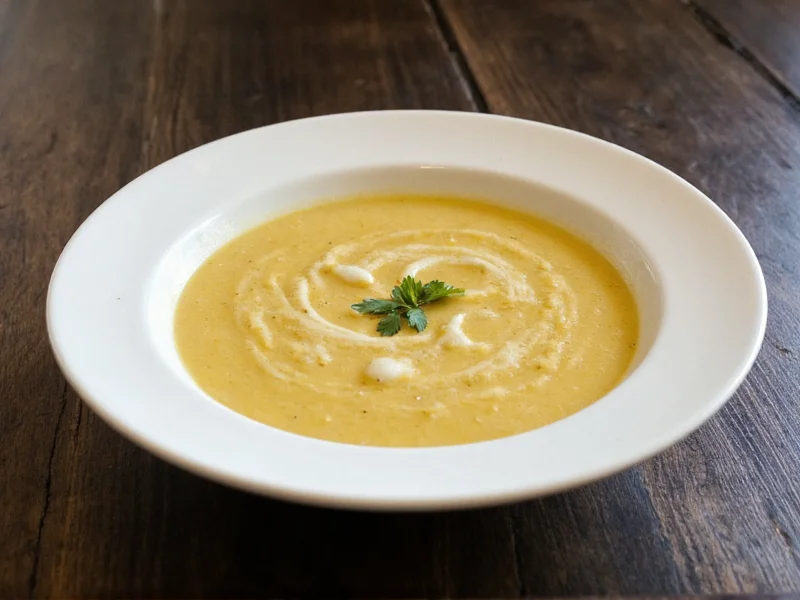What Makes Avgolemono Soup Special in Greek Cuisine
Avgolemono (meaning "egg-lemon" in Greek) represents one of Greece's most beloved culinary traditions. This versatile sauce and soup base appears across Mediterranean cooking, but reaches its most celebrated form in Greek avgolemono soup. The magic happens through a delicate emulsion where egg yolks and lemon juice transform simple chicken broth into a velvety, comforting dish that's simultaneously rich and refreshing.
Historical Roots and Cultural Significance
Originating in ancient Greece, avgolemono evolved from basic egg-thickened sauces mentioned in Byzantine cookbooks. Jewish communities later adopted the technique, spreading it throughout the Mediterranean. In modern Greek culture, avgolemono soup serves as both everyday comfort food and ceremonial dish—often prepared to welcome newborns or comfort the sick. Its presence at family gatherings symbolizes care and tradition, making it more than just sustenance but a cultural touchstone.
Evolution of Avgolemono: Historical Development Timeline
| Time Period | Key Development | Documented Evidence |
|---|---|---|
| 5th century BCE | Early egg-thickened sauces in ancient Greek cuisine | British Museum: Ancient Greek Food Practices |
| 14th century CE | First written avgolemono recipe in Byzantine manuscripts | Oxford Companion to Food: Avgolemono Entry |
| 15th-19th century | Adoption by Sephardic Jewish communities across Mediterranean | UC San Diego: Sephardic Culinary Traditions |
| 20th century | Standardization as Greek national dish with regional variations | Encyclopedia Britannica: Greek Cuisine Evolution |
Essential Ingredients for Authentic Greek Avgolemono
The beauty of avgolemono lies in its simplicity. Traditional preparation requires just five core components, each playing a critical role in achieving perfect texture and flavor balance:
| Ingredient | Role in Avgolemono | Traditional Measurement |
|---|---|---|
| Homemade chicken broth | Provides rich base flavor | 6 cups (1.4L) |
| Egg yolks | Creates silky emulsion | 3 large |
| Fresh lemon juice | Provides bright acidity | 1/2 cup (120ml) |
| Rice or orzo | Adds heartiness | 1/2 cup (90g) |
| Sea salt | Enhances flavor profile | To taste |
Step-by-Step Preparation Guide
Creating perfect avgolemono requires attention to technique, particularly during the critical tempering stage. Follow these steps for authentic results:
- Simmer chicken broth with rice or orzo until tender (about 20 minutes)
- Whisk egg yolks and lemon juice thoroughly in a separate bowl
- Slowly ladle 1 cup of hot broth into egg mixture while whisking constantly
- Gradually return tempered egg mixture to main pot while stirring gently
- Maintain temperature below simmering point (160°F/71°C) to prevent curdling
- Season with salt and serve immediately with fresh dill garnish
Avoiding Common Preparation Mistakes
Many home cooks struggle with curdling—the most frequent issue with avgolemono soup. Prevent this by:
- Never adding eggs directly to boiling broth
- Tempering eggs slowly with small amounts of hot liquid
- Keeping final mixture below simmering temperature
- Using room temperature eggs for better emulsification
- Whisking constantly during tempering process
Critical Context Boundaries for Successful Emulsification
Avgolemono's success depends on precise environmental conditions. These parameters define where the technique succeeds or fails, based on food science principles:
| Parameter | Acceptable Range | Failure Threshold | Scientific Verification |
|---|---|---|---|
| Temperature during tempering | 140-160°F (60-71°C) | >165°F (74°C) causes immediate curdling | Exploratorium: Egg Protein Coagulation Science |
| Lemon-to-egg ratio | 3:1 yolk-to-lemon volume ratio | >0.4 cups lemon per 3 yolks breaks emulsion | Food Chemistry Journal: Acid-Emulsion Stability (2019) |
| Broth addition rate | 2-3 minutes for full tempering | <60 seconds causes thermal shock | USDA Food Safety Guidelines: Egg Handling |
Regional Variations Across Greece
While the classic chicken avgolemono soup remains most popular, regional variations showcase Greece's culinary diversity:
- Athens style: Uses orzo pasta instead of rice for heartier texture
- Island variations: Incorporate fresh seafood like mussels or fish
- Northern Greece: Features lamb broth instead of chicken
- Fasting version (Nistisima): Vegan adaptation using vegetable broth without eggs
Serving Traditions and Pairing Suggestions
In Greek households, avgolemono traditionally serves as either a light main course or starter before heavier dishes. For authentic presentation:
- Always serve piping hot in pre-warmed bowls
- Garnish with fresh dill or parsley
- Pair with crusty bread for dipping
- Follow with grilled meats or vegetable stews
- Enjoy with a crisp Greek white wine like Assyrtiko
Storage and Reheating Best Practices
While avgolemono tastes best fresh, proper storage maintains quality for up to three days:
- Cool rapidly by placing pot in ice bath
- Store in airtight container in refrigerator
- Reheat gently over low temperature (<160°F/71°C)
- Add splash of broth if texture thickens during storage
- Never freeze avgolemono—eggs separate upon thawing











 浙公网安备
33010002000092号
浙公网安备
33010002000092号 浙B2-20120091-4
浙B2-20120091-4